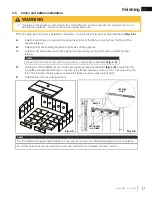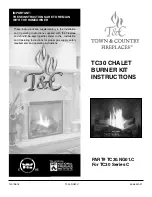
W415-2797 / A / 01.31.20
EN
20
5.0 operation
Your Napoleon EPA listed product is designed with the most advanced technology. The appliance is extremely airtight.
The fi rst fi re(s) in your appliance will be diffi cult to get going and keep going with little amount of heat being generated. This
is a result of the moisture being driven out of the fi re brick. During the break-in period (the fi rst 2 or 3 fi res) create only small,
fi res using kindling; this will allow the fi rebrick to cure. Do not be alarmed if small hairline cracks develop in the fi rebrick. This
is a normal occurrence and does not pose a safety hazard. The paint may also smell a little for the fi rst few fi res as it cures
and you may wish to open a door or window to alleviate the smell.
To start, a brisk fi re is required. Place loosely crumpled paper on the fl oor of the appliance and cover with dry kindling.
Open the air control fully by sliding control all the way to the right. Light the paper and leave the door slightly ajar (one inch)
until all kindling is burning. To maintain a brisk fi re, a hot coal bed must be established and sustained.
Slowly add larger wood (2x4 size pieces). Lay the pieces lengthwise from side to side in the hot coal bed with a shallow
trench between, so that the primary air can fl ow directly into this trench and ignite the fuel above. When the fi re seems
to be at its peak, medium sized logs may be added. Once these logs have caught fi re, carefully close the door. (Closing
the door too quickly after refueling will reduce the fi rebox temperature and result in an unsatisfactory burn.) Remember it
is more effi cient to burn medium sized wood, briskly, and refuel frequently than to load the appliance with large logs that
result in a smouldering, ineffi cient fi re and dirty glass.
As soon as the door is closed, you will observe a change in the fl ame pattern. The fl ames will get smaller and lazier
because less oxygen is getting into the combustion chamber. The fl ames, however, are more effi cient. The fl ames will
remain lazy but become larger again as soon as the fi rebricks have been heated thoroughly and the chimney becomes
heated and provides a good draft. At this point, the roaring fi re that you see when the door is opened is wastefully drawing
heated room air up the chimney, certainly not desirable. Always operate with the door fully closed once the medium sized
logs have caught fi re.
You can now add larger pieces of wood and operate the appliance normally. Once the appliance is entirely hot,
it will burn very effi ciently with little smoke from the chimney. There will be a bed of orange coals in the fi rebox
and secondary fl ames fl ickering just below the top baffl es. You can safely fi ll the fi rebox with wood to the top of
the door and will get best burns if you keep the appliance pipe temperatures between 250°F (120°C) and 450°F
(270°C). A surface thermometer will help regulate this.
Without an appliance thermometer, you are working blindly and have no idea of how the appliance is operating! An
appliance thermometer offers a guide to performance.
Can’t get the fi re going?
Use more kindling and paper. Assuming the chimney and vent are sized correctly and
there is suffi cient combustion air, the lack of suffi ciently dry quantities of small kindling is the problem. Thumb size
is a good gauge for small kindling diameter.
Can’t get heat out of the appliance?
One of two things may have happened. The appliance door may have
been closed prematurely and the appliance itself has not reached optimum temperature. Reopen the door and/
or draft control to re-establish a brisk fi re. The other problem may have been wet wood. The typical symptom is
sizzling wood and moisture being driven from the wood.
!
WARNING
•
Always operate this appliance with the door closed and latched except during start up and re-fueling.
Always wear gloves to prevent injury. Do not leave the fi re unattended when the door is unlatched as
unstable wood could fall out of the fi re chamber creating a fi re hazard to your home.
•
Never leave children unattended when there is a fi re burning in the appliance.
•
Never use gasoline, gasoline-type lantern fuel, kerosene, charcoal lighter fl uid, or similar liquids to start or
“freshen up” a fi re in this appliance. Keep all such liquids well away from the appliance while it is in use.
•
Objects placed in front of the appliance should be kept a minimum of 48” from the front face.
•
Any modifi cation of the appliance that has not been approved in writing by the testing authority is
considered breaching CSA B365 (Canada) and ANSI/NFPA 211 (USA).
•
Open air control (and damper when fi tted) before opening fi ring door.
•
Hot while in operation. Keep children, clothing and furniture away. Contact may cause skin burns. Wear
gloves to operate your appliance.
•
Burning your appliance with the doors open or ajar creates a fi re hazard that may result in a house and or
chimney fi re.
•
This wood appliance has a manufacturer-set minimum low burn rate that must not be altered. It is against
federal regulations in the United States to alter this setting or otherwise operate this wood appliance in a
manner inconsistent with operating instructions in this manual.
















































